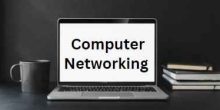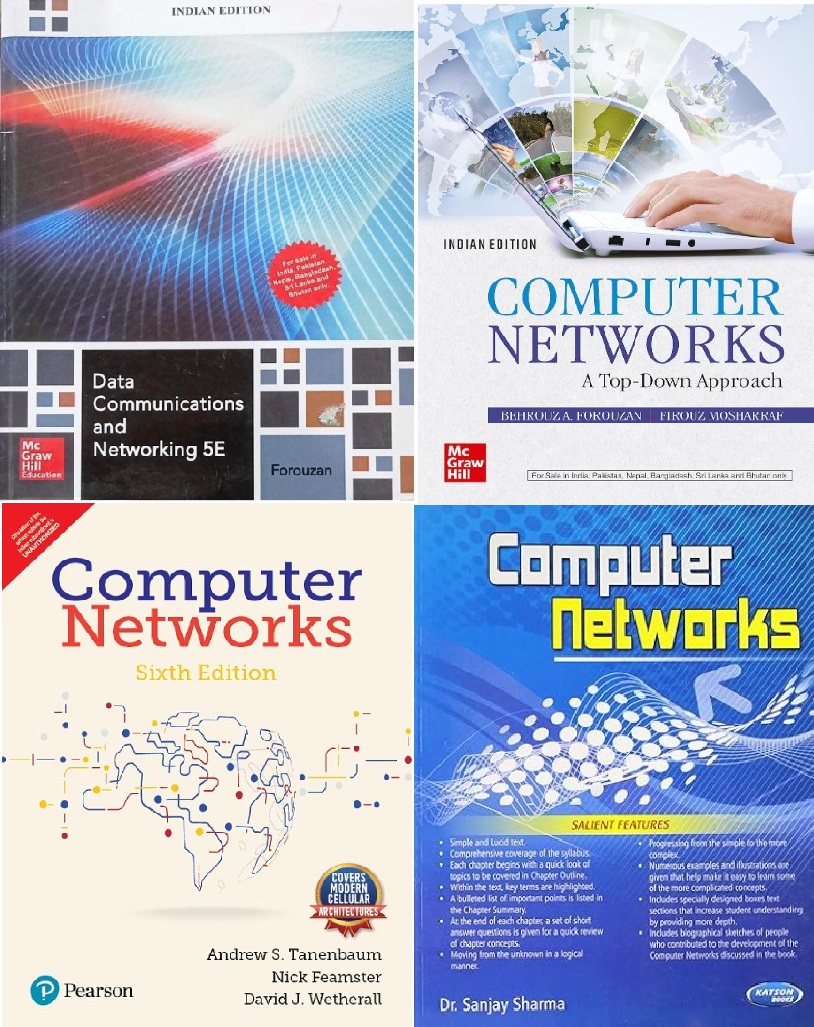Unit 3
Data Link Layer: Introduction, Framing, Error Detection and Correction, Flow control (Elementary Data Link Protocols, Sliding Window protocols), Medium Access Control and Local Area Networks: Channel allocation, Multiple access protocols, LAN standards, Link layer switches & bridges (learning bridge and spanning tree algorithms).
Q1 – Error detection at the data link level is achieved by
Bit stuffing
Cyclic redundancy codes
Hamming codes
Equalization
Ans – (2)
Explanation –
Cyclic redundancy codes (CRC) are commonly used for error detection in data link layer protocols. They provide a way to detect accidental changes to raw data by generating a checksum from the data and comparing it at both ends of the transmission.
Q2 – Which of the following ISO level is more closely related to the physical communication facilities?
Application
Session
Network
Data link
(Timothy Williams, McGraw Hill Education)
Ans – (4)
Explanation –
The Data Link layer (Layer 2 in the OSI model) is responsible for providing a reliable link between two directly connected nodes over a physical network.
It deals with error detection and correction from the physical layer (Layer 1) and ensures that data is transmitted to the correct device on a LAN using hardware addresses (MAC addresses).
Q3 – In a token ring network, the transmission speed is 107 bps and the propagation speed is 200 meters/µs. The 1-bit in this network is equivalent to
500 meters of cable
200 meters of cable
20 meters of cable
50 meters of cable (GATE)
Ans – (3)
Explanation –
Bit Time = 1/Transmission Speed = 1/107 s
Bit Length = Propagation Speed × Bit Time
Bit Length = 200 meters/µs × 1/107 s
Bit Length=200*1000000 meters/s x 1/10000000 s
Bit Length = 20 meters
Q4 – The Hamming distance between 001111 and 010011 is
1
2
3
4
(Williams Timothy, McGraw Hill Education)
Ans – (3)
Explanation –
At position 2, the symbols are different (0 in the first string, 1 in the second string).
At position 3, the symbols are different (1 in the first string, 0 in the second string).
At position 4, the symbols are different (1 in the first string, 0 in the second string).
Q5 – The message 11001001 is to be transmitted using the CRC polynomial x3 + 1 to protect it from errors. The message that should be transmitted is
11001001000
11001001011
11001010
110010010011
(GATE)
Ans – (2)
Explanation –
CRC polynomial x3 + 1 = 1001
The message = 11001001
On dividing the message by polynomial, we get 011
The codeword = original message + three bits by dividing = 11001001011
Q6 – The message 11011011 should be transmitted using CRC polynomial x3 + x + 1. In order to protect it from errors, it will be transmitted as
11011011001
11011011100
11011011110
None
Ans – (3)
Explanation –
The coefficient of x3 + x + 1 is 1011.
In the message, we append 3 zeros that x3 is there.
If we divide 11011011000 by 1011, then the remainder is 110
So, we transmit as 11011011110.
Q7 – In selective repeat ARQ is using 8-bit to represent the sequence number. What is the size of the window?
128
8
64
None
Ans – (1)
Explanation –
Given that 8 bits are used to represent the sequence number, the maximum number of unique sequence numbers that can be represented is 28 = 256.
Since selective repeat ARQ allows the sender to send multiple frames before receiving acknowledgments, the window size is usually half of the sequence number space to ensure efficient use of resources and to avoid unnecessary retransmissions.
Therefore, the size of the window in this case would be 256/2 = 128
Q8 – HDLC is
Bit oriented
Code transparent
Code dependent
none
(Timothy Williams, McGraw Hill Education)
Ans – (1, 2)
Explanation –
Bit-oriented – HDLC operates at the bit level, meaning it handles individual bits in the data stream rather than characters or bytes.
Code transparent – This means that HDLC does not impose any restrictions on the type or format of data being transmitted. It can carry data in various formats, including binary data, without requiring any specific encoding or translation.
Q9 – The parameter that is normally achieved through a trailer added to the end of the frame is
Access Control
Flow Control
Error Control
Physical addressing.
Ans – (3)
Explanation – In network communication, error control is often achieved through the addition of a trailer to the end of the frame. This trailer typically contains error detection information, such as a Frame Check Sequence (FCS) or Cyclic Redundancy Check (CRC), which allows the receiver to detect if any errors have occurred during the transmission of the frame.
Q10 – Bit stuffing refers to
inserting a 0 in user data stream to differentiate it with a flag
inserting a 0 in flag stream to avoid ambiguity
appending a nibble to the flag sequence
appending a nibble to the user data stream.
(Timothy Williams, McGraw Hill Education)
Ans – (1)
Explanation –
Bit stuffing is a technique used in data transmission to avoid synchronization problems caused by consecutive identical bits or sequences of bits that might resemble control characters. It involves inserting extra bits into the data stream to ensure that no bit patterns within the data accidentally match control characters or other reserved sequences.
The extra 0 bits are added to the user data stream to distinguish it from the flag sequence.
Q11 – In a datalink protocol, the frame delimiter flag is given by 0111. Assuming that bit stuffing is employed, the transmitter sends data sequence 01110110 as
01101011
011010110
011101100
0110101100
Ans – (4)
Explanation –
The frame delimiter flag is 0111, and the data sequence 01110110. Both have (0111). So, in data sequence, after two 1’s we apply bit stuffing 0 as to make data sequence unique.
Flag Data-Sequence Flag – 0111 0110101100 0111
Q12 – “Parity bits” are used for which of the following purposes?
Encryption of data
To transmit faster
To detect errors
To identify the user
Ans – (3)
Explanation –
Parity bits are used for detecting errors in transmitted data. They are added to data transmissions to help ensure the accuracy of the data. When data is transmitted, a parity bit is calculated based on the number of bits set to one in the data. This parity bit is then sent along with the data. At the receiving end, the parity bit is checked to see if the number of bits set to one in the received data matches the expected parity. If there is a mismatch, it indicates that an error has occurred during transmission.
Q13 – Choose the correct statement(s)
Baseband network uses analog technology
Baseband network is Time Divison Multiplexed
Broadband network uses digital technology.
In broadband network, the carrier signals operate at lower frequency
(Timothy Williams, McGraw Hill Education)
Ans – (2)
Explanation –
Baseband network is Time Division Multiplexed (TDM) – This statement is correct. In some contexts, especially in the context of local area networks (LANs), baseband networks can indeed use time-division multiplexing (TDM) to share the medium among multiple users.
Broadband network uses digital technology – This statement is generally correct but not correct all the time. Broadband networks often use digital technology to transmit multiple signals simultaneously over a single medium.
Q14 – Find out the OSI layer, which performs token management.
Network Layer
Transport Layer
Data link Layer
Presentation Layer
Ans – (3)
Explanation –
The OSI layer which performs token management is the Data Link Layer, which is Layer 2 of the OSI model.
Token management typically occurs in network protocols such as Token Ring, where a token is passed around the network to regulate access to the shared network medium.
Q15 – What is the meaning of Carrier Sense in CSMA (Carrier Sense Multiple Access)?
The ability to check the shared transmission medium whether it is being used by any other node or not
The ability to restrict other nodes to access the shared medium
The ability to gain access to the shared medium
None of the above
Ans – (1)
Explanation –
“Carrier Sense” refers to the capability of a network device to listen to the transmission medium to determine if it is free or if another device is currently transmitting data. This helps in avoiding collisions by ensuring that the medium is clear before sending data.
Q16 – What are the advantages of Carrier Sensing?
Sensing a carrier can avoid simultaneous transmissions by other nodes
It will help in reducing retransmission of data frames due to collisions with other station data frames
It improves performance of the network as the individual nodes sense for a carrier present in the transmission medium before requesting access to it.
All of the above
Ans – (4)
Explanation –
Carrier sensing helps prevent multiple nodes from transmitting at the same time, which reduces the likelihood of collisions.
By avoiding simultaneous transmissions, carrier sensing reduces the number of collisions, leading to fewer retransmissions of data frames.
Carrier sensing improves network performance by ensuring that nodes only transmit when the medium is clear, reducing collisions and improving overall efficiency.
Q17 – In ethernet CSMS/CD, the special bit sequence transmitted by media access management for collision handling is called
Preamble
Postamble
Jam
None
(Timothy Williams, McGraw Hill Education)
Ans – (3)
Explanation –
In Ethernet CSMA/CD (Carrier Sense Multiple Access with Collision Detection), the special bit sequence transmitted by the media access management for collision handling is called the “Jam” signal.
When a collision is detected, the colliding stations send out a jam signal to ensure that all other stations on the network are aware of the collision. This helps in ensuring that all stations involved in the collision are aware that a collision has occurred and that they should retransmit their frames after a random backoff period.
Q18 – What happens in an Ethernet network implementing CSMA-CD when a collision is detected?
The station retransmits the frame again immediately
The station retransmits the lost frames after a delay
The station retransmits the all frames after a delay
The station aborts the whole transmission of data
Ans – (2)
Explanation –
When a collision is detected, both stations involved in the collision stop transmitting immediately.
Each station sends a jam signal to ensure all stations on the network are aware of the collision.
Each station waits for a random backoff period before attempting to retransmit. This delay is determined using the binary exponential backoff algorithm.
After the delay, the stations attempt to retransmit the lost frames.
Q19 – CSMA/CA method is best suited for a ___ network.
Wired
Wireless
both a and b
None of the above
Ans – (2)
Explanation –
In wireless networks, stations cannot detect collisions like in wired networks (CSMA/CD). Instead, CSMA/CA focuses on avoiding collisions by checking if the channel is busy before transmitting data.
Q20 – The Frame Check Sequence (FCS) of an Ethernet Frame is a ___ code.
Cyclic Error Check
Cyclic Redundancy Check
End of Frame
Beginning of Frame
Ans – (2)
Explanation –
The FCS in an Ethernet frame is a field that contains a value computed using the Cyclic Redundancy Check (CRC) algorithm. This value is used for error detection, allowing the receiving device to verify if the data in the frame has been corrupted during transmission.



